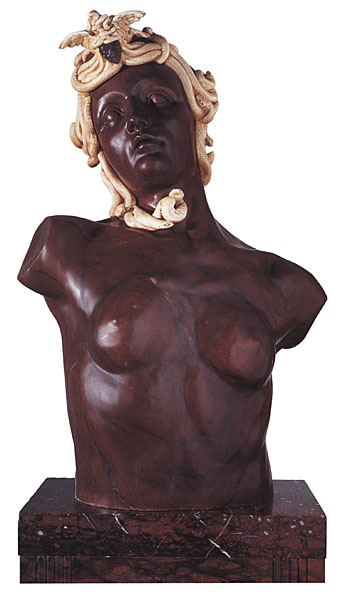Narcissus by Paul Dubois (1866).
Via a Flickr page of sculpture photography.
A journal by artist and designer John Coulthart.
Art
top left: Bob Pepper (1969); right: David Johnston (1974).
bottom left: Mati Klarwein (1972); right: Gervasio Gallardo (1972).
I wrote about the classic line of fantasy paperbacks in the Ballantine Adult Fantasy series last year as part of the post about Bob Pepper’s illustration:
It was the success of the publication of The Lord of the Rings in America which inspired Betty Ballantine to publish a line of fantasy classics in the late Sixties. The series began its run in 1969 and continued until 1974. Lin Carter was commissioned as editor and given free reign to choose any title he thought might be suitable with the result that many of the books in the series—obscurities such as Lud-in-the-mist by Hope Mirrlees—received their first paperback publication. Carter also reprinted personal favourites which frequently shifted from fantasy to outright horror, such as the titles from HP Lovecraft and William Hope Hodgson. The range and scope of this line is what makes the series so notable today and the books have become highly-collectable as a result.
I’m fairly sure this page of cover scans of the BAF series wasn’t there when I was searching for Pepper covers. Whether it was or not, it contains a lot of Bob Pepper artwork I hadn’t seen before at large size, plus a substantial number of the other covers. I was never all that taken with Gervasio Gallardo’s work which took the lion’s share of the illustration duties but the passage of time has lent his paintings and their florid title designs the distinction of being emblematic of the era. And some of the rest are still pretty decent covers.
Elsewhere on { feuilleton }
• The illustrators archive
• The book covers archive
Previously on { feuilleton }
• The art of Bob Pepper
• Fantastic art from Pan Books

Maléficia (1905).
Much of the jewellery and sculpture produced by Phillipe Wolfers demonstrates the tendency of Art Nouveau and decorative Symbolism to evolve from Decadence to full-blown Gothic. The sinister recurs in Wolfers’ creations whether in the form of baleful females such as Malèficia and his Medusa pendant, or in the shape of bats, insects and the ubiquitous fin de siècle serpent. There’s more Wolfers on the web than there was a couple of years ago but still too little; I scanned Malèficia from a book and swiped the bat brooch belt buckle (also a book scan) from Beautiful Century.
Large dragonfly (1903–04).
Le Jour et la Nuit (1897).
Previously on { feuilleton }
• Lalique’s dragonflies
• Lucien Gaillard
• The Masks of Medusa
One of the best—and most entertaining—films to come out of the Dada/Surrealist period, Entr’acte (1924) is also worth watching for the appearance of notable figures such as Francis Picabia (who initiated the project), Marcel Duchamp, Man Ray and Erik Satie.
This extraordinary early film from director René Clair was originally made to fill an interval between two acts of Francis Picabia’s new ballet, Relâche, at the Théâtre des Champs-Elysées in Paris in 1924. Picabia famously wrote a synopsis for the film on one sheet of note paper, headed Maxim’s (the famous Parisian restaurant), which he sent to René Clair. This formed the basis for what ultimately appeared on screen, with some additional improvisations. Music for the film was composed by the famous avant-garde composer Erik Satie, who appears in the film, along side its originator, Francis Picabia. The surrealist photographer Man Ray also puts in an appearance, in a film which curiously resembles his own experimental films of this era.
Entr’acte is a surrealistic concoction of unrelated images, reflecting Clair’s interest in Dada, a fashionable radical approach to visual art which relied on experimentation and surreal expressionism. Clair’s imagery is both captivating and disturbing, giving life to inanimate objects (most notably the rifle range dummies), whilst attacking conventions, even the sobriety of a funeral march.
Entr’acte can be watched and downloaded at Ubuweb. Tate Modern is running a major exhibition of the works of three of the participants, Duchamp, Man Ray, Picabia, until 26 May, 2008.
Previously on { feuilleton }
• Alexander Hammid
• Impressions de la Haute Mongolie revisited
• Short films by Walerian Borowczyk
• The South Bank Show: Francis Bacon
• Rose Hobart by Joseph Cornell
• Some YoYo Stuff
• Beckett directs Beckett
• Meshes of the Afternoon by Maya Deren
• Not I by Samuel Beckett
• La Villa Santo Sospir by Jean Cocteau
• Un Chant D’Amour by Jean Genet
• Borges documentary
• Film by Samuel Beckett
• Towers Open Fire
‘Fair and False’, Songs and Sonnets by William Shakespeare (1915).
More illustrated gems from the collection of books at the Internet Archive. Charles Robinson, as mentioned earlier, was the older brother of illustrator William Heath (there was also a third illustrator brother in the family, Thomas). Charles was so prolific it’s difficult to choose one work over the many examples available in the Internet Archive, so here’s a brief selection from different books. If you only look at one of these, his oft-reprinted edition of A Child’s Garden of Verses by Robert Louis Stevenson is especially fine. There’s a distinct Art Nouveau flavour to much of Charles Robinson’s work and he also devoted more attention to page layout than his younger brother, many of his drawings being presented within sinuous frames and augmented by some very elegant lettering. If they haven’t been digitised already at Fontcraft’s Scriptorium, some of these type designs would make great fonts.
A Child’s Garden of Verses by Robert Louis Stevenson (1895).
Lullaby-land : Songs of Childhood by Eugene Field (1897).
Fairy tales from Hans Christian Andersen (1899).
‘The Red Shoes’, Fairy tales from Hans Christian Andersen (1899).
The Story of the Weathercock by Evelyn Sharp (1907).
The Happy Prince and Other Tales by Oscar Wilde (1913).
Elsewhere on { feuilleton }
• The illustrators archive